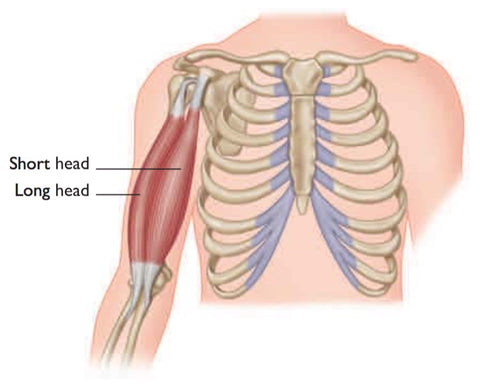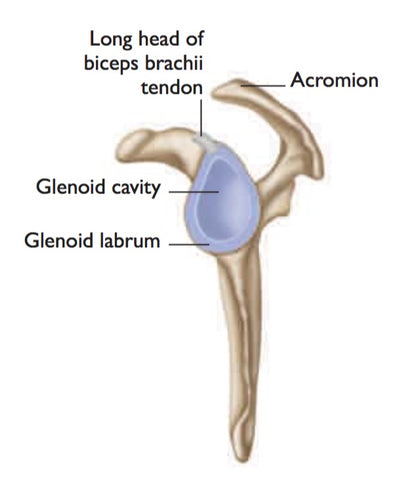Sports Injuries - Biceps Brachii Tendon Rupture

Biceps Brachii - Ruptures typically result from sudden trauma to the biceps brachii tendon
Biceps brachii tendon ruptures can occur from weight lifting or throwing sports but are generally uncommon, particularly in young athletes
Repetitive strain, particularly due to over-lifting, can lead to irritation and microscopic tears in the biceps brachii tendon, which connects the biceps brachii muscle to the scapula at the proximal end, and the radius and fascia of the forearm at the distal end.
A biceps brachii tendon rupture typically results from sudden trauma to the biceps brachii tendon. Injury at the proximal end of the tendon of the long head of biceps is most common.
Biceps brachii tendon ruptures can occur from weight lifting or throwing sports but are generally uncommon, particularly in young athletes.
In older individuals it is often the result of degenerative change or previous injury to the tendon.
Cause of injury
Weakness due to tears in the rotator cuff. Throwing activities. Weightlifting.
Signs and symptoms
Bulge in the upper arm. Inability to turn the palm upward. Sudden, sharp pain at the shoulder.

Tears may affect older individuals as a result of degenerative change or previous injury to the tendon.
Complications if left unattended
Generally, little functional loss accompanies rupture of a proximal biceps brachii tendon, as two tendinous attachments occur at the shoulder, one compensating the other in most cases.
For this reason, surgery is rarely required and complications are rare, though without proper healing, re-tearing and degeneration of the tendon are more likely.
Immediate treatment
Anti-inflammatory and analgesic medications to reduce pain. RICER regimen immediately following injury. Later heat to promote blood flow and healing.
Rehabilitation and prevention
Following rest and recovery of the tendon, flexibility and strengthening exercises should be undertaken to restore full mobility in the shoulder.
Avoidance of sudden lifting beyond normal capacity and violent loading to the biceps brachii tendon as during throwing sports may help prevent the injury.
Long-term prognosis
Most biceps brachii tendon ruptures resolve without medical intervention if given proper time for healing. In younger athletes with demanding training schedules, surgery may be contemplated to repair the rupture.
Tears and ruptures to the distal end of the biceps brachii tendon at the elbow are more rare but can be more severe, requiring surgery. In both cases the prospects for full recovery are excellent.
Find a Trigger Point Professional in your area
This trigger point therapy blog is intended to be used for information purposes only and is not intended to be used for medical diagnosis or treatment or to substitute for a medical diagnosis and/or treatment rendered or prescribed by a physician or competent healthcare professional. This information is designed as educational material, but should not be taken as a recommendation for treatment of any particular person or patient. Always consult your physician if you think you need treatment or if you feel unwell.
About Niel Asher Education
Niel Asher Education (NAT Global Campus) is a globally recognised provider of high-quality professional learning for hands-on health and movement practitioners. Through an extensive catalogue of expert-led online courses, NAT delivers continuing education for massage therapists, supporting both newly qualified and highly experienced professionals with practical, clinically relevant training designed for real-world practice.
Beyond massage therapy, Niel Asher Education offers comprehensive continuing education for physical therapists, continuing education for athletic trainers, continuing education for chiropractors, and continuing education for rehabilitation professionals working across a wide range of clinical, sports, and wellness environments. Courses span manual therapy, movement, rehabilitation, pain management, integrative therapies, and practitioner self-care, with content presented by respected educators and clinicians from around the world.
Known for its high production values and practitioner-focused approach, Niel Asher Education emphasises clarity, practical application, and professional integrity. Its online learning model allows practitioners to study at their own pace while earning recognised certificates and maintaining ongoing professional development requirements, making continuing education accessible regardless of location or schedule.
Through partnerships with leading educational platforms and organisations worldwide, Niel Asher Education continues to expand access to trusted, high-quality continuing education for massage therapists, continuing education for physical therapists, continuing education for athletic trainers, continuing education for chiropractors, and continuing education for rehabilitation professionals, supporting lifelong learning and professional excellence across the global therapy community.

Continuing Professional Education
Looking for Massage Therapy CEUs, PT and ATC continuing education, chiropractic CE, or advanced manual therapy training? Explore our evidence-based online courses designed for hands-on professionals.



















